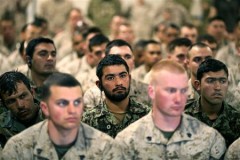LatinaLista — The recent horrific act by a US Army staff sergeant killing 16 Afghan children and adults in cold blood defies explanation. Whether the soldier suffered from brain trauma, post-traumatic stress disorder or was in a state of delusional drunkeness when he committed these crimes against humanity is up to the officials in charge to determine.

What is clear is that this soldier wasn’t in his right frame of mind. Unfortunately, the same can’t be said for his military comrades who burned copies of the Quran or have harassed and hazed soldiers of color in their units — driving some to commit suicide.
The extent of the insensitivity displayed by white soldiers towards other ethnicities has reached a tipping point with members of Congress recently demanding the military start enacting diversity initiatives that were outlined in a report last year compiled by the Military Leadership Diversity Commission.
According to the Commission’s findings:
These data show that, as of September 2008, officers were generally less demographically diverse than both the enlisted troops they led and the civilian population they served. In addition, compared with their representation in the ranks below, racial/ ethnic minorities and women were underrepresented among senior noncommissioned officers across several Services in both the Active Component (AC) and Reserve Component (RC). Finally, women (with the exceptions noted above) and racial/ethnic minorities were underrepresented among flag/general officers in both the AC and RC.
Given the desire to develop and maintain a military leadership that is demographically representative of the American public, it follows that military leadership should also represent the servicemembers it is entrusted to lead. Leaders from racial/ ethnic and cultural backgrounds similar to those of the U.S. citizenry have the potential to inspire future servicemembers and engender trust among the population.
With only 13 percent of active-duty officers either Black or Latino, compared with Blacks and Latinos comprising 27 percent of the U.S. population, the military knows they have a problem. But the sad reality is that they have a bigger problem because many of the target demographic they want to attract to the military can’t qualify.
The reasons sound like a laundry list of ailments we know impact a portion of Latino youth: obesity, poor grades, criminal history, drug use, etc.
Given the ultimatum to start diversifying their ranks, each military branch is undertaking diversity initiatives. The Marine Corps. announced this week the launch of a new multimedia campaign.
The campaign dubbed “Toward the Sounds of Chaos” doesn’t just focus on the combat aspect of military life but also the humanitarian assistance and disaster relief that soldiers are deployed to do.
The research suggests that youth have traditionally viewed military service as a route to personal focus and improvement, but that a third of young Americans naturally inclined toward military service are equally likely to value military involvement in humanitarian missions as they are to support a military response to a terrorist attack. The Marines concede that youth view military with high admiration, but not the level of aspiration or prestige they associate with college.
If the military succeeds in improving diversity within their ranks there is no guarantee that attitudes will improve towards soldiers of color. For that to happen, it can’t be a directive from superiors but a personal realization that race or ethnicity make no difference when fighting a common adversary because the only ones who have each other’s backs are those on the same team.


